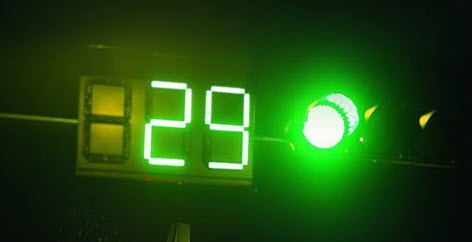As much as I enjoy rethinking things, the conventional traffic light design has too many things going for it, despite the unfortunate color choices.
While changing the paradigm to a two state FSM may make more logical "sense," there are a few reasons the three state system is in place and why it works.
Which color the stop light is currently is a legal matter. You can pass legally or you can pass illegally; the simple states provide immediate and absolute information regarding whether you are in accordance or violation of the law.
As has been mentioned there are certain fears that a countdown may cause some people to intentionally speed up (much as the yellow light does), whether that's the case or not would require research. However I would never want my users "eyeball" legality; it's legal to do X or it's not. I don't want just anyone to assume "Yes, I can probably legally cross that intersection". It's obviously a problem with yellow lights as well, but this is a case where giving users more information might cause them to make riskier or more poorly informed decisions. While we can clearly indicate exactly how much time remains on the light the matter of whether one will cross the light while red or green is too complex of an equation to ask people to perform accurately.
Secondly, the colors of light is seen as a state, even if it is an indication of progress. All solutions I've seen that make an effort to indicate progress rather than state are significantly more complicated than the simple 3 colors, 3 positions set up, and users are likely to still think of the system in terms of 3 states.
The progress/timer concept also seems to exacerbate, not alleviate the problem of the 3 states of the standard traffic light. The third "yellow" state wavers between "stop" or "I should speed up" depending on the user, giving them raw data to support this claim seems questionable, especially when you're murkying the legal matter of "do I stop or do I go". And as I said before, it's not raw data that's easily and objectively operated on. In traffic things should be as direct and objective as possible.






